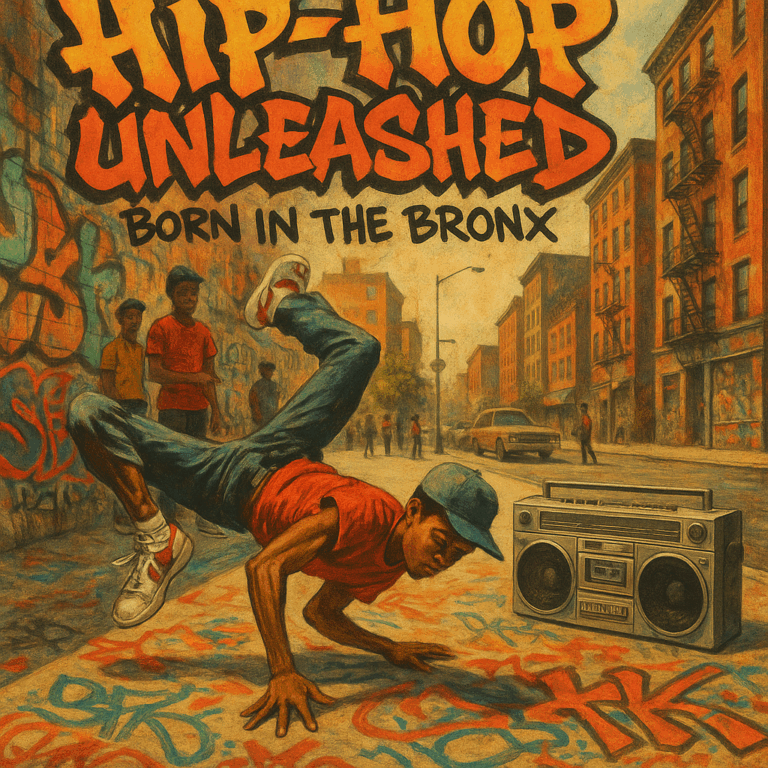The Birth of a Cultural Movement: Hip-Hop’s Musical Revolution
If American music were a sprawling metropolis, hip-hop would be its vibrant, graffiti-splattered neighborhood pulsing with life and stories. Emerging from the socio-economic enigmas of the Bronx in the late 1970s, hip-hop was more than just a genre—it was an audacious cultural declaration. This was a time when urban decay met youthful creativity, and DJs transformed street parties into electric gatherings by spinning vinyl records with breakbeats so infectious they could make concrete crack.
Hip-hop’s birth was poetic, fueled by pioneers like DJ Kool Herc, who, with his innovative “breakbeat” technique, looped the most danceable fragments of funk and soul records, giving birth to the breakdance scene and sparking the sonic foundation of the genre. This wasn’t just music; it was a call to arms, a voice for marginalized communities to narrate their lived realities over beats crafted from turntables and ingenuity.
The Essence: More Than Just Beats—A Cultural Tapestry
At its core, hip-hop is a multi-dimensional art form encompassing four quintessential elements: DJing, MCing (or rapping), breakdancing, and graffiti art. This holistic approach created a genre that was as much a visual and performative culture as it was sonic. The genre’s rhythmic complexity is anchored in syncopated beats, looping samples, and lyrical flow that often blends storytelling, social commentary, and playful bravado in a seamless musical dance.
Interestingly, hip-hop’s genre-fluid DNA has allowed it to absorb influences from jazz, rock, reggae, and electronic dance music (EDM), making it an ever-evolving powerhouse reflective of urban life’s shifting dynamics. Dance music aficionados will appreciate how hip-hop’s groove-driven pulse found synergy with EDM’s electrifying energy, inspiring collaborations and crossovers that explode on dance floors worldwide.
Architects of Influence: The Key Players Who Shaped Hip-Hop
When talking key artists, the hall of fame is illustrious and diverse. Grandmaster Flash, with his pioneering turntable techniques, gave birth to DJing as a performative craft. Then, the Sugarhill Gang’s “Rapper’s Delight” (1979) catapulted hip-hop into the American music mainstream, proving that rhythmic rhymes and funky beats could sell records.
The 1980s brought a new wave: Run-DMC combined street style with rock influences, especially on their iconic collaboration with Aerosmith on “Walk This Way,” shattering genre barriers. Public Enemy’s politically charged tracks like “Fight the Power” turned hip-hop into a powerful platform for activism, blending dense sampling with razor-sharp lyricism.

Now, dance music enthusiasts and club DJs can’t ignore the impact of producers like Dr. Dre, whose polished beats on albums like “The Chronic” helped birthed G-Funk, adding a shimmering synth feel that laid a bridge toward electronic sounds. More recently, Kanye West and Kendrick Lamar have pushed the boundaries, fusing indie influences and experimental production that reimagine hip-hop’s sonic landscape.
Anthems that Shaped the Soundtrack of Generations
Certain songs and albums don’t just dominate charts; they define cultural epochs. The Notorious B.I.G.’s “Ready to Die” (1994) encapsulates gritty East Coast storytelling with velvety flows that journeyed into the psyche of urban America. Tupac Shakur’s “All Eyez on Me” doubled down on raw emotion, exploring themes of violence, vulnerability, and resilience, making it a timeless classic.
For fans of the dance floor, Missy Elliott’s boundary-breaking “Supa Dupa Fly” brought futuristic beats and innovative music videos that married hip-hop with electronic whimsy. OutKast shattered southern stereotypes with “Stankonia,” bringing funk, soul, and psychedelic touches into hip-hop’s fold.
Additionally, albums like Lauryn Hill’s “The Miseducation of Lauryn Hill” not only blended hip-hop with soulful melodies but created an emotional resonance that lingers across generations. On the production side, DJ Shadow’s “Endtroducing…..” is a revered masterpiece of sample-based music, a hypnotic journey that inspired both hip-hop and EDM producers.
Enduring Legacy: Hip-Hop’s Everlasting Impact on Global Culture
Hip-hop’s influence goes beyond beats and rhymes—it’s a global movement that has shaped fashion, language, politics, and identity. The genre gave marginalized voices a megaphone and birthed a fashion revolution with iconic staples like Kangol hats, Adidas sneakers, and baggy pants becoming symbols of cultural pride.
Dance music and EDM scenes have embraced hip-hop’s rhythmic complexity and sampling techniques, resulting in eclectic festival sets where DJs weave rap verses into bass drops, creating a hybrid energy that turns crowds into euphoric collectives. Hip-hop’s lexicon has infiltrated everyday speech, while its DIY ethos continues to inspire artists worldwide to innovate without constraints.
Moreover, hip-hop has challenged industry norms, offering platforms for women and LGBTQ+ voices to rise and be heard in a genre historically dominated by male perspectives. This evolution mirrors the genre’s foundational spirit of resistance and reinvention.
In the grand narrative of American music, hip-hop stands tall as a beacon of creativity born from adversity—a genre that transformed turntables and street corners into stages of cultural celebration. Its infectious beats, lyrical prowess, and relentless reinvention keep it pulsing at the heart of musical innovation, forever inviting new generations to embrace the culture, move to the rhythm, and tell their stories with swagger and soul. If you’ve ever been drawn to the club’s vibrant energy or danced until dawn to thumping electronic beats, you’ve already felt hip-hop’s enduring heartbeat echo through the soundtrack of our lives.